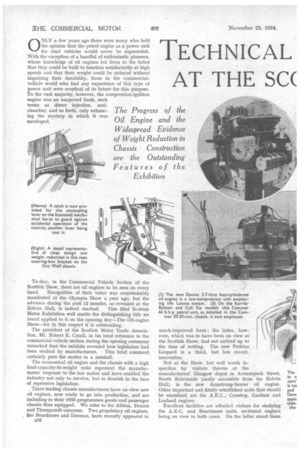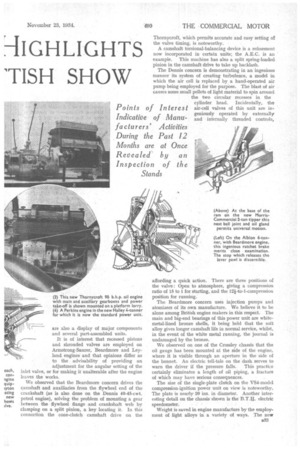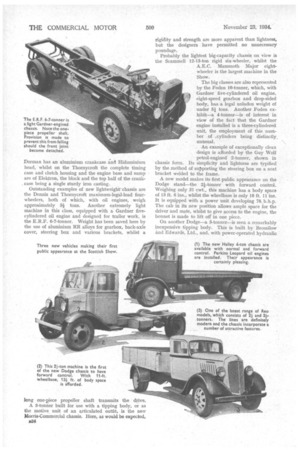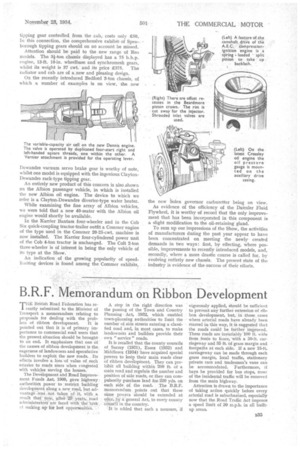TECHNICAL AIGHLIGHTS AT THE SC( 'FISH SHOW
Page 46

Page 47

Page 48

Page 49

If you've noticed an error in this article please click here to report it so we can fix it.
0NIX a few years ago there were many who. held the opinion that the petrol engine as a power unit . for road vehicles would never be superseded. With the exception of a handful of enthusiastic pioneers, whose knowledge of oil engines led them to the belief that they could be built to function satisfactorily at high speeds and that their weight could be reduced without impairing their durability, those in the commercialvehicle world who had any experience of this type of power unit were sceptical of its future for this purpose. To the vast majority, however, the compression-ignition engine Was an unopened book, such terms as direct injection, antichamber, and so forth, only enhancing the mystery in which it was enveloped.
To-day, in the Commercial Vehicle Section of the Scottish Show, there are oil engines to be seen on every hand. Recognition of their value was unmistakably manifested at the Olympia Show a year ago, but the advance during the past 12 months, as revealed at the Kelvin Hall, is indeed marked. This 33rd Scottish Motor Exhibition well merits the distinguishing title we heard applied to it on the opening day--The Oil-engine Show—for in this respect it is outstanding. The president of the Scottish Motor Trade Association, Mr. Robert E. Croall, in his brief reference to the commercial-vehicle section during the opening ceremony remarked that the exhibits revealed how legislation had been studied by manufacturers. This brief comment certainly puts the matter in a nutshell.
The economical oil engine and the chassis with a high load-capacity-to-weight ratio represent the manufacturers' response to the law maker and have enabled the industry not only to survive, but to flourish in the face of repressive legislation.
Three leading chassis manufacturers have on view new oil engines, now ready to go into production, and are including in their 1935 programmes goods and passenger chassis thus equipped. We refer to the Albion, Dennis and Thornycroft concerns. Two proprietary oil engines, the Beardmore and Dorman, have recently appeared in n32
(1) The new Dennis 5.7-litre four-cylindered oil engine is a low-compression unit employing the Lanova system. (3) On the Karrier Bantam and Cob Six models this Commer 44 b.h.p. petrol unit, as installed in the Corn mer 20-25-cwt. chassis, is now employed.
much-improved form ; the latter, however, which was to have been on view at the Scottish Show, had not arrived up to the time of writing. The new Perkins Leopard is a third, but less recent, innovation.
Not at the Show, but well worth in spection by visitors thereto at the manufacturers' Glasgow depot in Avenuepark Street, North Kelvinside (easily accessible from the Kelvin Hall), is the new Armstrong-Saurer oil engine. Other important and firmly established units that should be examined are the A.E.C., Crossley, Gardner and Leyland engines. Excellent facilities are afforded visitors for studying the A.E.C. and Beardmore limits, sectioned engines being on view in both cases. On the latter stand there
(2) This new Thornycroft 98 b.h.p. oil engine with main and auxiliary gearboxes and power take-off is shown mounted on a platform lorry. (4) A Perkins engine in the new Halley 4-tonner for which it is now the standard power unit.
are also a display of major components and several part-assembled units.
It is of interest that recessed pistons and shrouded valves are employed on Armstrong-Saurer, Beardmore and Leyland engines and that opinions differ as to the advisability of providing an adjustment for the angular setting of the inlet valve, or for making it unalterable after the engine leaves the works.
We observed that the Beardmore concern drives the camshaft and anyiliaries from the flywheel end of the crankshaft (as is also done on the Dennis 40-45-cwt. petrol engine), solving the problem of mounting a gear between the flywheel flange and crankshaft web by clamping on a split pinion, a key locating it. In this
connection the cone-clutch camshaft drive on the
Thomycroft, which permits accurate and easy setting of the valve timing, is noteworthy.
A camshaft torsional-balancing device is a refinement now incorporated in certain units; the A.E.C. is an example. This machine has also a split spring-loaded pinion in the camshaft drive to take up backlash.
The Dennis concern is demonstrating in an ingenious manner its system of creating turbulence, a model in which the air cell is replaced by a hand-operated air pump being employed for the purpose. The blast of air causes some small pellets of light material to spin around the two circular recesses in the cylinder head. Incidentally, the air-cell valves of this unit are ingeniously operated by externally and internally threaded controls, affording a quick action. There are three positions of the valve : Open to atmosphere, giving a compression ratio of 15 to 1 for starting, and the 12i-to-I-compression position for running.
The Beardmore concern uses injection pumps and atomizers of its own manufacture. We believe it to be alone among British engine makers in this respect. The main and big-end bearings of this power unit are whitemetal-lined bronze shells, it being held that the soft alloy gives longer camshaft life in normal service, whilst, in the event of the white metal running, the journal is undamaged by the bronze.
We observed on one of the Crossley chassis that the oil gauge has been mounted at the side of the engine, where it is visible through an aperture in the side of the bonnet. An electric tell-tale on the dash. serves to warn the driver if the pressure falls. This practice certainly eliminates a length of oil piping, a fracture of which may have serious consequences.
The size of the single-plate clutch on the VS4-model compression-ignition power unit on view is noteworthy. The plate is nearly 20 ins, in diameter. Another inter esting detail on the chassis shbwri is the electric speedometer.
Weight is saved in engine manufacture by the employment of light alloys in a variety of ways. The new Dorman has an aluminium crankcase a'nel Hiduminium head, whilst on the Thornycroft the complete timing case and clutch housing and the engine base and sump are of Elektron, the block and the top half of the crank. case being a single sturdy iron casting.
Outstanding examples of new lightweight chassis are the Dennis and Thornycroft maximum-legal-load, fourwheelers, both of which, with oil engines, weigh approximately 8tons. Another extremely light machine in this class, equipped with a Gardner fiveeylindered oil engine and designed for trailer work, is the E.R.F. 6-7-tanner. Weight has been saved here by the use of aluminium RR alloys for gearbox, back-axle cover, steering box and various brackets, whilst a rigidity and strength are more apparent than lightness, but the designers have permitted no unnecessary poundage.
Probably the lightest big-capacity chassis on view is the Scammell 12-13-ton rigid six-wheeler, whilst the A.E.C. Mammoth Major eightwheeler is the largest machine in the Show.
The big classes are also represented by the Foden 10-tanner, which, with Gardner five-cylindered oil engine, eight-speed gearbox and drop-sided body, has a legal unladen weight of under 5f tons. Another Foden exhibit—a 4-tonnes—is of interest in view of the fact that the Gardner engine installed is a three-cylindered unit, the employment of this number of .cylinders being distinctly. unusual.
An example of exceptionally clean design is afforded by the Guy Wolf petrol-engined 2-tanner, shown in chassis form. Its simplicity and lightness are typified by the method of supporting the steering box on a neat bracket welded to the frame.
A new model makes its first public appearance on the Dodge stand—the 2-f-tonner with forward control. Weighing only 31 cwt., this machine has a body space of 13 ft. 6 ins., whilst the wheelbase is only 10 ft. 11 ins. It is equipped with a power unit developing 78 b.h.p. The cab in its new position allows ample space for the driver and mate, whilst to give access to the engine, the bonnet is made to lift off' in one piece.
On another Dodge—a 3-tonner—is seen a remarkably inexpensive tipping body. This is built by Bromilow and Edwards, Ltd., and, with power-operated hydraulic
tipping gear controlled from the cab, costs only £50. In this connection, the comprehensive exhibit, of Spen-. borough tipping gears should on no account be missed.
Attention should be paid to the new range of Reo models. The 31-ton chassis displayed has a 75 blip. engine, 13-ft. 10-in, wheelbase and synchromesh gears, whilst its weight is 37 cwt. and its price £375. The radiator and cab are of a new and pleasing design.
On the recently introduced Bedford 3-ton chassis, of which a number of examples is on view, the. new
Dewandre vacuum servo brake gear is worthy of note, whilst one model is equipped with the ingenious ClaytonDewandre rack-type tipping gear.
An entirely new product of this concern is also shown on the Albion passenger vehicle, in which is installed the new Albion oil engine. The device to which we refer is a Clayton-Dewandre diverter-type water heater.
While examining the fine array of Albion vehicles, we were told that a new 40-seater with the Albion oil engine would shortly be available.
In the Karrier Bantam four-wheeler and in the Cob Six quick-coupling tractor-trailer outfit a Commer engine of the type used in the Commer 20-25-cwt. machine is now installed. The Karrier four-cylindered power unit of the Cob 4-ton tractor is unchanged. The Colt 2-ton three-wheeler is of interest in being the only vehicle of its type at the Show.
An indication of the growing popularity of speedlimiting devices is found among the Comrner exhibits, the new Solex governor carburetter being on view.
As evidence of the efficiency of the Daimler Fluid Flywheel, it is worthy of record that the only improvement that has been incorporated in this component is a slight modification to the oil-retaining gland.
To sum up our impressions of the Show, the activities of manufacturers during the past year appear to have been concentrated on meeting the newly created demands in two ways : first, by effecting, where possible, improvements to recently introduced models, and, secondly, where a more drastic course is called for, by evolving entirely new chassis. The present state of the industry is evidence of the -success of their efforts.




























































































